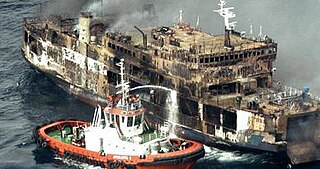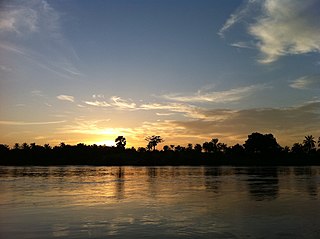Related Research Articles

MV Le Joola was a Senegalese government-owned roll-on/roll-off ferry that capsized off the coast of The Gambia on 26 September 2002, with 1,863 deaths and 64 survivors. It is thought to be the second-worst peacetime disaster in maritime history.

The MS al-Salam Boccaccio 98 was an Egyptian Ro/Ro passenger ferry, operated by El Salam Maritime Transport, that sank on 3 February 2006 in the Red Sea en route from Duba, Saudi Arabia, to Safaga in southern Egypt.

Levina 1 was an Indonesian passenger ferry. On 22 February 2007, it caught fire, killing at least 51 people. Three days later, on 25 February, it sank with a group of journalists and investigators on board, killing at least one more and leaving three missing.
Mossuril District is a district of Nampula Province in north-eastern Mozambique based in the principal town of the same name. Mossuril is a coastal district located in the Bay of Mossuril. It is eight kilometres from Mozambique Island by boat or approximately 51 kilometres by road. The district is said to be home to the oldest surviving European building in the Southern Hemisphere, the church of Nossa Senhora dos Remédios in the village of Cabaceira. The beaches of Chocas Mar, at the far tip of the district, are also a popular tourist attraction.

Vector was a Philippine oil tanker that collided with the passenger ferry Doña Paz on December 20, 1987 in the Tablas Strait, Philippines, resulting in the deaths of an estimated 4,385 passengers and crew from the two ships. The incident is considered the deadliest peacetime maritime disaster in history.

The 2009 Sierra Leone ferry accident occurred on 8 September 2009 off the coast of Sierra Leone, when a wooden Teh Teh ferry travelling from Shenge village to Tombo sank during a storm. At least 90 people to date have been confirmed dead, and over 100 others have been listed as "missing". So far, only 39 survivors have been rescued. Several of the passengers were children who had been on holiday, though the official passenger manifest did not include them. An attempted rescue operation ended on 11 September. The sinking is the worst such accident in Sierra Leone since 2002, when a boatful of refugees capsized. The Xinhua News Agency in China has likened the disaster to other major marine accidents in recent years.

Bulgaria was a class 785/OL800 Russian river cruise ship which operated in the Volga-Don basin. On 10 July 2011, Bulgaria sank in the Kuybyshev Reservoir of the Volga River near Syukeyevo, Kamsko-Ustyinsky District, Tatarstan, Russia, with 201 passengers and crew aboard when sailing from the town of Bolgar to the regional capital, Kazan. The catastrophe led to 122 confirmed deaths.

MV Rabaul Queen was a passenger ferry owned by the Papua New Guinea company Rabaul Shipping. The ship, built in Japan in 1983, operated on short runs in that country, before being brought to Papua New Guinea in 1998 and plying a regular weekly route between Kimbe, the capital of West New Britain, and Lae, the capital of the mainland province of Morobe.

On the morning of April 16, 2014, the ferry MV Sewol sank whilst en route from Incheon towards Jeju City in South Korea. The 6,825-ton vessel sent a distress signal from about 2.7 kilometres north of Byeongpungdo at 08:58 KST. Out of 476 passengers and crew, 304 died in the disaster, including around 250 students from Danwon High School in Ansan. Of the 172 survivors, more than half were rescued by fishing boats and other commercial vessels that arrived at the scene approximately 40 minutes before the Korea Coast Guard (KCG).
The South Korean ferry Seohae sank on October 10, 1993 in the Yellow Sea near Wido, Buan County, North Jeolla Province. Of those on board, 292 of the 362 passengers and crew on board were killed. Seventy people were rescued.
On 21 March 2019, a ferry carrying passengers on the Tigris River near Mosul capsized and sank, killing 103 people, 12 of them children. The capsize was caused by overcrowding on-board the vessel, and by high water levels on the Tigris. Many of the passengers were celebrating the Kurdish New Year.

The ferry Rodney capsized and sank on Sydney Harbour 13 February 1938 with the loss of 19 lives. The ferry was carrying well-wishers and girlfriends of sailors on the heavy cruiser USS Louisville as it left the Harbour.
This article lists events from the year 2024 in Mozambique.

On 10 June 2024, the ship HB la Saintet sank in the Kwa River, a tributary of the Congo River in the Democratic Republic of the Congo, killing at least 86 people including 21 children.
References
- 1 2 Mutsaka, Farai (8 April 2024). "At Least 90 Dead After Ferry Sinks Near Mozambique". TIME . Archived from the original on 11 April 2024. Retrieved 13 April 2024.
- ↑ "More than 90 killed as boat sinks off northern coast of Mozambique". France 24. 7 April 2024. Archived from the original on 13 April 2024. Retrieved 13 April 2024.
- 1 2 3 4 5 Tembe, Jose; Booty, Natasha; Vock, Ido (8 April 2024). "Mozambique ferry disaster kills more than 90—officials". BBC News. Archived from the original on 13 April 2024. Retrieved 8 April 2024.
- 1 2 3 "At least 100 dead in Mozambique after ferry boat capsizes". Al Jazeera English. 9 April 2024. Archived from the original on 13 April 2024. Retrieved 10 April 2024.
- 1 2 3 Ibrahim, Essimela; Tembe, Jose (10 April 2024). "Mozambique ferry disaster: 'I survived - but lost 17 of my family'". BBC News. Archived from the original on 13 April 2024. Retrieved 13 April 2024.
- ↑ "Mozambique: over 90 people killed after boat sinks". Africanews. 8 April 2024. Archived from the original on 8 April 2024. Retrieved 8 April 2024.
- ↑ "Dodental scheepsramp Mozambique opgelopen tot boven 100" [Death toll in Mozambique ship disaster rises to over 100] (in Dutch). Nederlandse Omroep Stichting. 9 April 2024. Archived from the original on 12 April 2024. Retrieved 9 April 2024.
- ↑ Townsend, Mark (8 April 2024). "Disinformation on cholera led to Mozambique ferry disaster, officials say". The Guardian . ISSN 0261-3077. Archived from the original on 10 April 2024. Retrieved 9 April 2024.
- ↑ Mucari, Manuel (8 April 2024). "Over 100 dead in Mozambique ferry incident, president says". Reuters . Retrieved 13 April 2024.
- ↑ "100 People Died After Ferry Boat Sank in Mozambique, President Says". Voice of America. 9 April 2024. Archived from the original on 10 April 2024. Retrieved 10 April 2024.